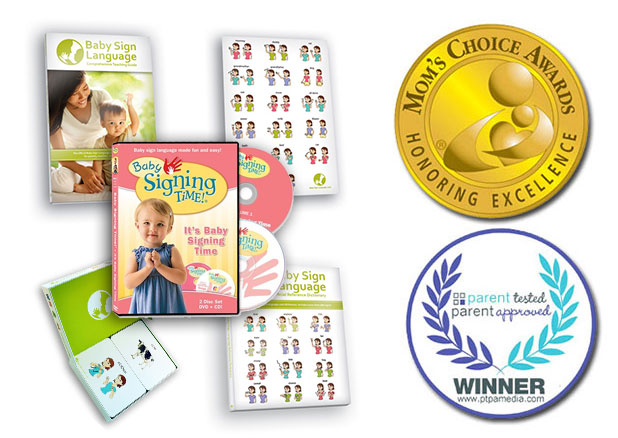Step Three:
Encouraging All Efforts
Once your baby starts signing, you want to reward her efforts with lots of encouragement. Learning to sign is challenging for babies and a little encouragement helps keep them engaged.
- Approximations – recognizing early signs
- Stages of Signing – development of signing
- Forms of Encouragement – ways to encourage signing
1. Introduction
Signing is naturally fun. Did you ever notice that babies who are just a few months’ old will often smile or giggle when you sign at them, even before they understand signing? Getting your undivided attention and knowing that you are trying to play with them is inherently enjoyable to babies; they have a natural curiosity and will find joy in learning how to communicate.
Fun is important because fun helps baby learn faster. When signing is a favorite part of her day, baby will be more motivated to try signing and stick with it even if it feels difficult at first. Fun is also important because it sets the foundation for future learning interactions. This is your first time teaching baby and you want to establish the pattern that learning from you is something he wants to do.
To keep signing fun, we set a playful tone, we use signs that baby is motivated to learn, and we sign at the right time and place.
2. Approximations
At first, the signs your baby makes will only be an approximation of the proper baby signs. Babies don’t have the motor skills to do the signs perfectly, so they will make approximations. These approximations are usually a less-detailed version of the full sign and may barely be recognizable. Parents often miss these first attempts at signing if they aren’t on the lookout.
Approximations tend to involve the gross motor muscles but will be missing a lot of the fine detail. For example, the sign for daddy is properly performed be tapping the thumb on the forehead. Your baby’s first approximations will usually look more like they are just flailing their arms up and down. The baby may also use both hands instead of just one hand.
Timing of the initial signs is often delayed. The baby will often sign back as much as 60 seconds after you initiated signing. It takes a lot of effort for babies to control their arms and hands, so you will often see a look of intense concentration as the baby thinks about signing, followed by a burst of hand movements.
In the video above, note how Kennedy signs more (at the 0:30 mark) and uses only one hand instead of both. The movement is much too big and uses the gross motor muscles in the arm and not the fine muscles in the fingers. Kennedy’s signing is a few seconds delayed, but it is still quite clearly an attempt to do the sign for more, which her mom is rewarding by acknowledging the attempt and giving her what she wants.
These approximations and delays are perfectly normal. They are the way that all babies start to sign. With practice, signing will become more precise and more prompt as their fine motor skills develop. You encourage your baby to improve their signing by recognizing and rewarding their approximations.
(Courtesy: Eat Clean Play)
3. Stages of Signing
You will usually see three stages of progression when starting with baby sign language:
Stage One: Imitation
The first step toward signing is that your baby will start copying your signs. A normal part of a baby’s development is to copy the gestures of the people around her. So when you are regularly performing the signs, your baby will naturally copy you and make the signs right back. While she does not understand what her signs mean at this stage, she is learning how to perform the signs making this a useful first step.
Your baby will think this is grand fun.
Stage Two: Association
In the second stage, your baby will start to associate the sign with some concept. She may start making the right sign when something triggers the association. For example, she will sign dog whenever the dog is nearby. At this stage, your baby has made the connection between the word and the concept.
Stage Three: Communication
The last stage is when your baby starts using the signs to communicate something to you. For example, if she is hungry, she may sign milk. In this last step, your baby has learned that she can use the signs to communicate her needs and feelings to you. This is the stage where signing really starts to get useful.
4. Motivating Signing
When you see baby signing, particularly those initial attempts to sign, you want to encourage their effort. There are many ways you can reward the signing as follows:
Acknowledgment
The most powerful thing you can do to reward your baby for signing is to acknowledge their attempt to communicate. Knowing that you understood what they are saying is a tremendously rewarding experience for a young child. So if your baby attempts the sign for cat, give her your full attention and repeat back to her the word cat as well as the sign cat.
Emotion
Respond to baby with enthusiasm, showing that you are excited about her signing. Show emotions and make exaggerated sounds and gestures to show that you are happy. You want to project a calm positive energy to show baby that she is doing something important. In much the same way you work hard to get a giggle out of your baby, your baby will want to work hard to keep getting this emotional reaction from you.
Gratification
Where possible, if baby makes a request via sign language, you want to gratify the request. So if baby signs water, get baby some water. This will not always be practical, but where it is possible, give baby what she wants.
When you can’t get baby what she wants, still provide acknowledgement and emotion as positive reinforcement. It is rarely a good idea to ever ignore an attempt to sign. This creates more frustration for baby, because not only is she not getting what she wants, she is also not feeling understood.
Next: Step Four – Expand Vocabulary
Previous: Step Three – Encourage
Start Signing With The Baby Sign Language Kit
Our award-winning Baby Sign Language Kits gets your baby signing faster.
- DVDs – baby learns to sign while being entertained by the music of Rachel Coleman & the Signing Time Crew
- Flash Cards – extend baby’s vocabulary to topics like household items and animals with these sturdy flash cards
- Teaching Guide – covers advanced topics for faster results, potty training, and transitioning to speech
- Signing Dictionary – always have the right sign at your fingertips to satisfy your child’s curiosity
- Wall Chart – help grandparents, babysitters, and caregivers understand the basic signs






